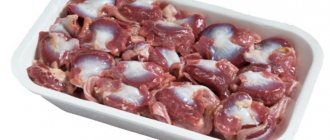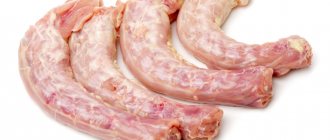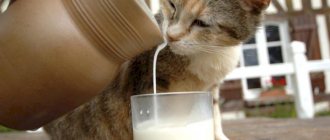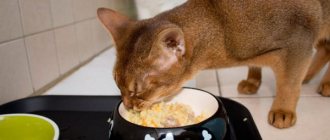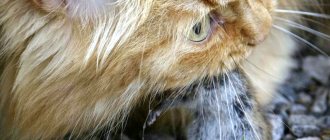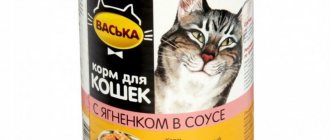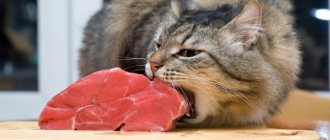As is known, the domesticated part of the cat family belongs to the order of carnivores. A lack of meat in food can cause diseases, poor health, and loss of activity in such animals. But in addition to meat, according to veterinarians, various offal products should also be included in the diet. They are ready to completely dispel doubts about whether cats can have chicken stomachs or not:
- Is it possible to feed a cat chicken stomachs?
Offal and offal are readily purchased by owners of furry pets, especially several. The reason is their low price, nutritional value, and the fact that pets love their smell and taste. To the question whether it is possible to give chicken stomachs to a cat, the answer will be positive. The product consists entirely of muscle tissue and contains virtually no fat. It is a good source of not only protein, but also collagen. In addition, there is a lot of iron, phosphorus, zinc and many other biologically important elements.
Veterinarians unanimously agree that chicken gizzards can be included in the diet for cats. However, you should not do this often; several times a week will be enough. This product is inferior in nutritional value to meat, so it cannot completely replace it. Also, an excess of protein along with an insufficient amount of fats and carbohydrates can lead to digestive and bowel problems in your pet. Particular care should be taken when giving chicken stomachs to kittens.
- How to cook chicken gizzards for cats
Owners of cats are often familiar with the capriciousness and pickiness in food of their pets. Trying to please, they select products that not only satiate, give strength and health, but also appeal to their pets.
According to veterinarians, a cat’s diet should contain not only processed meat products, but also raw ones. Otherwise, during cooking, a lot of useful and important substances for health are lost. However, many cat owners see raw meat products as a risk of infection by some pathogen and provide them only after thorough heat treatment.
How long should you cook chicken gizzards for a cat? This will take 15–20 minutes. An alternative may be cold treatment. But for this you need a freezer that maintains -20 degrees. The product is kept in the cold for at least 3 days.
It is advisable to cut chicken giblets into large pieces before giving them to your pets. Due to this, the teeth and jaws will receive the necessary load. Chopped food in the form of minced meat is less digestible, and small particles can remain in the teeth and lead to caries. Is it possible to give adult kittens chicken stomachs? Of course yes, but in this case they need to be cut smaller than for adults.
Quite often, cat owners are faced with poor tolerance of raw meat products in their pets. This manifests itself as vomiting or diarrhea. Feeding your pet naturally becomes difficult or even impossible. This situation means that he has problems with the digestive tract.
If you have doubts whether it is possible to feed your cat chicken gizzards, raw or boiled, then you should add them to the menu gradually, with an interval of 1–2 weeks. This period will allow you to see negative reactions in the animal and identify what caused them.
Recently, the phrase “a cat is an obligate predator” has often been heard. And it is true. Cats are not omnivores. But if you think that a predator needs to be fed meat, then you are deeply mistaken. Eating pure meat leads to serious health problems due to an imbalance of minerals, primarily calcium and phosphorus, and a lack of vitamins. Meat is an excellent source of complete protein, but otherwise it has a poor composition. Therefore, offal for cats is not a delicacy or pampering, but a necessary component of the diet.
The secret to the survival and relative well-being of the wild ancestors of the domestic cat was eating the prey whole. Usually it is a small rodent or bird. In addition to meat, the cat receives bones and cartilage, fatty brain, stomach and intestines with all contents, liver, kidneys, lungs - in other words, all internal organs.
How often to give your cat by-products, and in what quantity?
The share of by-products in the diet is calculated depending on their type. Muscular organs - the tongue, heart, gizzard of the bird - are given as part of the “meat” part of the diet, the total share of which is about 70%.
Internal organs (liver, kidneys, lungs, brains, spleen) provide 10-15% of the total diet. Another 10% should come from bones. Their sources are rabbit or poultry ribs, chicken necks and heads, and quail frames. The share of meat and bone ingredients is about 20%.
Chicken neck for a cat
If the cat has not eaten offal before, it needs to be introduced to it gradually, starting with microscopic quantities. When switching from dry food to natural food, the cat is first fed muscle meat, and then they begin to give various by-products, monitoring the pet’s individual reaction.
A variety of by-products is good for your pet
Muscle by-products can be fed to your cat daily, and some are fed 1-3 times a week to add variety to the diet. If, in response to feeding the internal organs, the cat's stool becomes thinner, their quantity is sharply reduced and the digestive tract begins to re-acclimate, gradually increasing the volume to the desired level.
Next, we will take a closer look at some types of by-products and their optimal quantity.
Chicken hearts: benefits and harms
The beneficial qualities of the product are associated with its multicomponent composition. In terms of the amount of amino acids and microelements, hearts are superior to other offal products. Vitamins from group B and PP promote good blood circulation and metabolism, stimulate the central nervous system, normalize liver fat metabolism, strengthen the immune system, and increase brain activity. Vitamin A will help strengthen your pet's vision. Retinol, which is part of the hearts, improves the skeletal system, skin and hair. The mineral composition has the following effects:
This product has a positive effect on the condition of the animal’s claws, as it contains everything necessary for their growth.
- normalizes the growth of claws and fur;
- promotes insulin production;
- improves heart function;
- stabilizes blood pressure.
The amino acids contained in the hearts will help normalize blood glucose levels, restore skin and muscle cells, and strengthen bones. In addition, they are able to remove toxins, improve immunity and cope with fat deposits. However, despite the positive qualities of the product, there are also negative aspects. One of them is cholesterol, which can be harmful to your cat's health. This is why you should not feed your pet chicken hearts often. There is also a kitten intolerance to the product. Some animals outright refuse to eat this product, as well as the feed that contains it. Vomiting and diarrhea are common after consumption.
By-products for cats are the only source of calcium
The most common mistake in natural feeding of cats is a violation of the ratio of calcium and phosphorus in food. For adult animals, the Ca:P balance should be approximately 1.2-1.7:1, for kittens 2:1. At the same time, most products, including meat, contain much more phosphorus than calcium.
The only chance to enrich the natural diet with calcium is to feed your pet not only meat, but also bones. To do this, chicken necks and heads are introduced into the diet.
Chicken heads: Cat's dinner can look creepy
Depending on the size and habits of the cat, chicken necks give:
- Entirely;
- Cut into pieces;
- Scrolled through a meat grinder as part of a meat mix.
Whole, sliced and twisted chicken necks
The hard and sharp beak is cut off from the chicken heads, and the heads themselves can first be beaten with a hammer.
Rules for feeding cats with bone by-products:
- Bones are given ONLY IN RAW FORM. Boiled bones are dangerous for cats.
- Bones should make up about 10% of the diet, which means 20-30% meat and bone ingredients.
- If the cat's feces become dry, white, or bowel movements are irregular (constipation), bones are excluded from the diet or their quantity is reduced.
- They only give spongy bones, not tubular bones (legs and wings are not allowed).
If you are afraid to give your cat bones or she cannot eat them for health reasons (diseases of the gastrointestinal tract, lack of teeth, etc.), calcium should be added to the diet in the form of commercial veterinary supplements.
Is it possible to give?
It is not possible to introduce chicken heart into a cat's diet, but it is necessary. This is done to provide a balanced diet for your pet. The offal contains a lot of protein and little fat, which has a beneficial effect on the healthy development of the cat's body. Chicken stomachs will also be beneficial for cats. By combining offal, you can make your diet more diverse in chemical and amino acid composition. By consuming these products, your baby will receive the full required amount of protein, calcium, iron, phosphorus, zinc and potassium.
Lungs - is it worth giving them to a cat?
One of the most useless beef by-products is lung. It is made of connective tissue and is difficult for cats to digest. In many animals, eating “airy” offal causes vomiting. Therefore, it is given in small quantities and in combination with meat or other organs.
It is quite possible to create a complete diet without using lungs, but if the cat likes their taste, they are fed in a volume of 5-15% of the diet. The peculiarity of this by-product is its low calorie content, which can be useful when preparing a diet for overweight animals.
If you cut the lung into small pieces and dry it in the oven, you will get an excellent delicacy. It is given to cats between main feedings.
Why is diet necessary?
Kidney failure poses a threat to your cat's health and life. In case of pathology in a sick cat, products resulting from metabolic processes accumulate in the body. The content of toxic components in the blood increases, as a result of which the animal may die. For this reason, it is extremely important to switch your pet to a balanced diet as soon as possible. The amount of meat is reduced by 40%.
The disease in cats occurs in acute or chronic form. In the first case, it is possible to cope with kidney failure by following a proper diet and taking the necessary medications. The chronic type of the disease is characterized by slow progression, while the tissues of the internal organ are irreversibly damaged. The diet is selected individually for each cat by a veterinarian. There are 2 types of diet food:
- natural;
- ready-made feed.
Veterinarians warn owners that nutrition in case of kidney failure in a cat must be strictly observed, since the disease progresses quickly and leads to complications at the slightest disturbance. Often, with kidney pathology, the pet does not eat anything; in this case, you need to try to compromise or force feed the animal. Hunger strikes should not be allowed under any circumstances, since there is a high probability of liver disorders being associated with renal failure.
Benefits of Eating Raw Food
Increased water consumption
Raw food is closest to a cat's natural diet. Modern cats are descended from carnivores that obtained most of their fluids from their prey. On average, 70% water could be obtained, while only 10% could be obtained from dry food. Cats do not always compensate for the imbalance by drinking large amounts of water, which can lead to urine concentration and crystal formation. Males are especially vulnerable because they have a narrower urethra, the passage that carries urine from the bladder out of the body. The narrow urethra of males is easily blocked by crystals or stones, making urination difficult or impossible. This condition is life-threatening and requires urgent veterinary attention.
Improving dental hygiene
Chewing raw meat removes plaque from your teeth. If not removed regularly, plaque hardens into tartar and leads to gum disease.
Weight maintenance
Dry food is rich in carbohydrates; they are stored as fat. Cats need a diet rich in protein, not carbohydrates. Obesity is a growing problem, with 50% of cats in Australia, the UK and the US being overweight, which carries significant health risks.
High taste characteristics
Not all, but a large number of cats prefer the taste and texture of raw food rather than dry or canned food.
How to reduce risks
It should be remembered that the standards for meat for animal consumption are not as high as for humans, so if you want to introduce meat into your diet, choose the same meat that you eat yourself.
Most nutritionally transmitted diseases occur due to improper storage of meat at home. Be careful when purchasing, transporting, storing and handling raw meat.
- Don't give your cat game: rabbit or kangaroo meat may contain lead fragments, which are very poisonous.
- Homemade minced meat: Minced meat can contain a large number of bacteria, and grinding the meat only multiplies them. If you want to give your cat minced meat, it is recommended to buy a steak, grind it at home and give it to your cat right away.
- Don't Rinse Meat: People usually rinse meat, especially chicken, before cooking, but this is not safe. When rinsing, bacteria spread to nearby surfaces. Instead, pat the chicken dry with a paper towel.
- Buy the meat you eat yourself: find a good butcher who will supply you with meat. Never buy meat if the packaging is bulging.
- Wash your hands: ALWAYS wash your hands with hot water and soap before and after handling raw meat.
- Don't leave meat out: Bacteria multiply quickly in warm environments, so remove and discard uneaten meat after 20 minutes.
- Don't cook raw meats/fruits/vegetables on the same board: you should have separate boards for raw meats and other foods, e.g. fruits and vegetables
- Wash dishes: Wash your cat's bowl, cutting board, and other utensils in hot, soapy water or, better yet, in the dishwasher.
- Storage: Never keep cooked and raw meat on the same plate. Store raw meat on the bottom shelf of the refrigerator to prevent juices from dripping onto cooked meat. Meat in the refrigerator must be properly packaged to avoid cross-contamination.
- Temperature: Store raw meat below 5°C
- Keep an eye on the expiration date: meat must be eaten before the expiration date, find out how long it can be stored in the refrigerator. As a rule, chicken or minced meat is stored for 1-2 days, and beef for three days (unless otherwise indicated in the expiration date).
- Large meals: Freeze meat in smaller portions.
- Thawing Meat: Place in refrigerator the night before to slowly defrost. Never defrost meat at room temperature.
